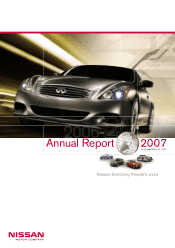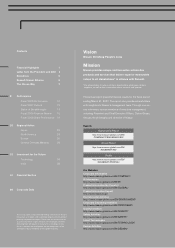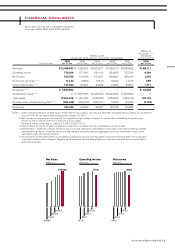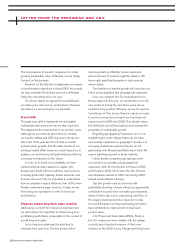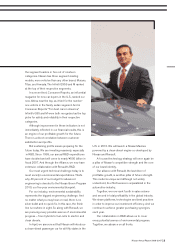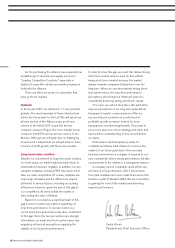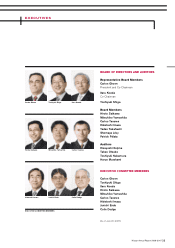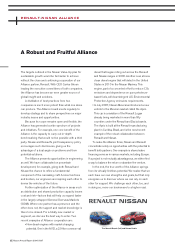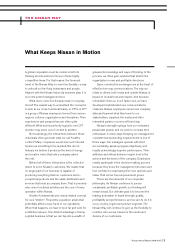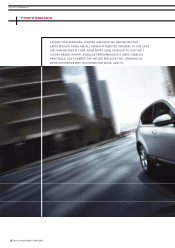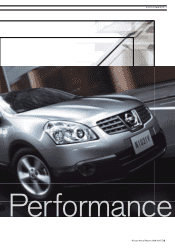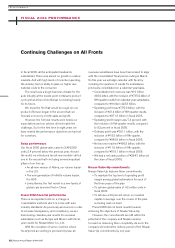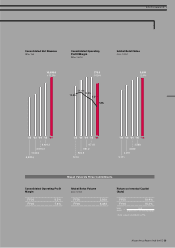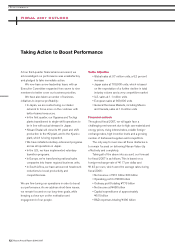Nissan 2007 Annual Report Download - page 4
Download and view the complete annual report
Please find page 4 of the 2007 Nissan annual report below. You can navigate through the pages in the report by either clicking on the pages listed below, or by using the keyword search tool below to find specific information within the annual report.
Nissan Annual Report 2006-2007
2
LETTER FROM THE PRESIDENT AND CEO
The sole purpose of a public company is to create
growing sustainable value. At Nissan, we are totally
focused on this purpose.
However, for the first time in eight years, we missed
our performance objectives in fiscal 2006. As a result,
we have extended the delivery period for all Nissan
Value-Up commitments by one year.
The stock market recognized this shortfall and
our share price mirrored our performance. However,
we believe we are well below our potential.
Fiscal 2006
This past year, all the headwinds we anticipated
materialized and were more severe than expected.
This happened the lowest point of our product cycle.
Although we successfully launched new models,
such as the Altima and G35, they were introduced
late in the fiscal year and did not lead to overall
annual volume growth. And the sales decline in our
existing models offset these successful launches. In
addition, our short-term profit potential was offset by
our heavy investments for the future.
In order to re-boost our profitability, we have
implemented several measures in Japan, U.S.,
Europe, and South Africa to address various issues
including production capacity, dealer networks, and
human resources. Yet, it is important to understand
how our situation today is different from 1999, when
Nissan underwent a major recovery. Today, we are
fine-tuning our operations in order to boost our
performance.
Progress toward long-term value creation
Addressing our short-term issues is important, but
we also believe it is important to achieve long-term
profitable growth that is measurable in the context of
a solid long-term plan.
In our long-term planning, the priority is to
maximize free cash flow. The key drivers will be
top-line growth, profitability, future investment
and economies of scale through the Alliance. We
have made significant progress in each area as
shown below.
The first driver of top-line growth will come from our
future product pipeline and geographical expansion.
Once we complete the 28 model launches for
Nissan Value-Up this year, we will introduce over 33
new products during the next three years. As we
embark on this product offensive, we are focused on
“smoothing out” the product-launch cadence in order
to avoid a new-product drought, such as those we
experienced in 2005 and 2006. This should reduce
the likelihood of profit fluctuations and increase the
possibility for sustainable growth.
Regarding geographical expansion, one of our
breakthroughs under Nissan-Value Up, we have
successfully expanded our geographic presence in
emerging markets as evidenced by the recent
partnership with Renault and Mahindra in India. We
expect significant growth in these markets.
Infiniti, another breakthrough, has also been
successful in accelerating its geographical
expansion. After its introduction in Korea in 2005
and Russia in 2006, Infiniti will enter the Chinese
and Ukrainian markets in 2007 and during 2008
extend across Western Europe.
Top-line growth must be achieved with
profitability. Growing volumes without an appropriate
contribution to profit does not make good business
sense. Profit is also key to maximizing cash flow. In
this regard, brand and product value are crucial.
Several third-party non-financial leading indicators
have exhibited our improvement in brand and
product value.
J. D. Power and Associates APEAL Study in
the U.S. measures owner delight with the design,
content, layout and performance of their new
vehicles. In the 2006 survey, Nissan and Infiniti were

